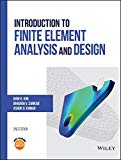
Concept explainers
Solve the differential equation in problem 8 for the following boundary conditions using the Galerkin method:
Assume the approximate solution as:
Compare the approximate solution with the exact solution by plotting their graphs. The exact solution can be derived as:
Want to see the full answer?
Check out a sample textbook solution
Chapter 2 Solutions
Introduction To Finite Element Analysis And Design
- 1. A spring mass system serving as a shock absorber under a car's suspension, supports the M=1000kgmass of the car. For this shock absorber,k=1000N/m and c=2000N s/m. The car drives over a corrugated road with force F=2000sin(wt)N. Use your notes to model the second order differential equation suited to thisapplication. Simplify the equation with the coefficient of x'' as one. Solve x (the general solution) interms of using the complimentary and particular solution method. In determining the coefficients ofyour particular solution, it will be required that you assume w2 -1=w or . Do not 1-w2=-wuse Matlab as its solution will not be identifiable in the solution entry. Do not determine the value of w.You must indicate in your solution:1. The simplified differential equation in terms of the displacement x you will be solving2. The m equation and complimentary solution3. The choice for the particular solution and the actual particular solution xp4. Express the solution x as a piecewise…arrow_forwardQuestion 2: Air at the temperature of T1 is being heated with the help of a cylindrical cooling fin shown in the figure below. A hot fluid at temperature To passes through the pipe with radius Rc. a) Derive the mathematical model that gives the variation of the temperature inside the fin at the dynamic conditions. b) Determine the initial and boundary conditions to solve the equation derived in (a). air T1 Re Assumptions: 1. Temperature is a function of onlyr direction 2. There is no heat loss from the surface of A 3. Convective heat transfer coefficient is constantarrow_forwardUse the graphical method to find the optimal solution for the following LP equations: Min Z=10 X1 + 25 X2 Subject to X1220, X2 ≤40 ,XI +X2 ≥ 50 X1, X2 ≥ 0.arrow_forward
- Integrate the function X^2+2*x on the interval 0 to 3 with a step size of .5 using the trapezoid rule.arrow_forward3. Using the trial function uh(x) = a sin(x) and weighting function wh(x) = b sin(x) find an approximate solution to the following boundary value problems by determining the value of coefficient a. For each one, also find the exact solution using Matlab and plot the exact and approximate solutions. (One point each for: (i) finding a, (ii) finding the exact solution, and (iii) plotting the solution) a. (U₁xx - 2 = 0 u(0) = 0 u(1) = 0 b. Modify the trial function and find an approximation for the following boundary value problem. (Hint: you will need to add an extra term to the function to make it satisfy the boundary conditions.) (U₁xx - 2 = 0 u(0) = 1 u(1) = 0arrow_forwardQuestion 2: Air at the temperature of T1 is being heated with the help of a cylindrical cooling fin shown in the figure below. A hot fluid at temperature To passes through the pipe with radius Rc. a) Derive the mathematical model that gives the variation of the temperature inside the fin at the dynamic conditions. b) Determine the initial and boundary conditions to solve the equation derived in (a). air To Re Assumptions: 1. Temperature is a function of only r direction 2. There is no heat loss from the surface of A 3. Convective heat transfer coefficient is constantarrow_forward
- (3) For the given boundary value problem, the exact solution is given as = 3x - 7y. (a) Based on the exact solution, find the values on all sides, (b) discretize the domain into 16 elements and 15 evenly spaced nodes. Run poisson.m and check if the finite element approximation and exact solution matches, (c) plot the D values from step (b) using topo.m. y Side 3 Side 1 8.0 (4) The temperature distribution in a flat slab needs to be studied under the conditions shown i the table. The ? in table indicates insulated boundary and Q is the distributed heat source. I all cases assume the upper and lower boundaries are insulated. Assume that the units of length energy, and temperature for the values shown are consistent with a unit value for the coefficier of thermal conductivity. Boundary Temperatures 6 Case A C D. D. 00 LEGION Side 4 z episarrow_forward2- Derive the rule-of-mixtures expression for the composite extensional modulus E₁ assuming the existence of an interphase region. The starting point for the derivation would be the model shown below. For simplicity, assume the interphase, like the matrix, is isotropic with modulus E¹. With an interphase region there is a volume fraction associated with the interphase (i.e.,V;). For this situation: vf + vm + vi = 1 H |w²||wm|arrow_forward2. As shown in the right figure, write out your solution strategy, including model, meshing(at least 2Nim with 4 elements), boundary conditions, and element type and shape functions, also write out the nodal force formula. Do not require computing. 2Nim 2m 2marrow_forward
 Principles of Heat Transfer (Activate Learning wi...Mechanical EngineeringISBN:9781305387102Author:Kreith, Frank; Manglik, Raj M.Publisher:Cengage Learning
Principles of Heat Transfer (Activate Learning wi...Mechanical EngineeringISBN:9781305387102Author:Kreith, Frank; Manglik, Raj M.Publisher:Cengage Learning
